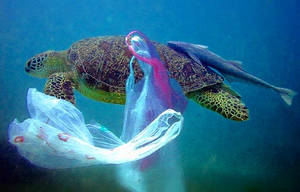How much plastic is in the ocean?
Interview with
According to the United Nations global plastic production has gone from 5.5 million  tonnes in the 1950s to 110 million tonnes in 2009. And because plastics are resistant to the processes that break down materials naturally, they can accumulate in the oceans.
tonnes in the 1950s to 110 million tonnes in 2009. And because plastics are resistant to the processes that break down materials naturally, they can accumulate in the oceans.
Captain Charles Moore from Algalita Marine Research Foundation was the first to document what he dubs the 'Great Pacific Garbage Patch, a huge floating mass of plastic aggregated by ocean currents. He told Kat Arney how he found this island.
Charles - Well, I found it by accident, returning from Honolulu to California. I took a shortcut through an area known as the doldrums or the north pacific high. So repeatedly, for an entire week, small bits of plastic floating by and decided to come back and measure it scientifically and found to my surprise that there were 6 times as much plastic as plankton floating on the surface in this area. So, what you've got is a plastic soup. Now, that soup is bulked out with larger croutons of material and in this last voyage, I actually found a floating island that I walked around and did a kind of a tour. I felt like Captain Cook. I mapped it. I took its position. I named the coves on it. It's quite exciting for a plastic researcher to find a floating plastic island. But basically, what you want to envision when you think of these garbage patches is the equivalent of hundreds of miles of harbour debris attached to each other basically from a couple of hundred miles up the California cost all the way to China in the case of the north pacific, which is my field of expertise.
Kat - So, my question is, where has this all come from?
Charles - It comes from everywhere. We live in the age of plastic. Our lives have plastic in them from dawn until dusk. We're creatures of the plastic age. They deliver our food, we wear them, we make our cars out of them. There's alternatives for every natural material out of plastic and alternatives for every manufacturing material from steel, to aluminium, to glass. All those natural materials that were formally the basic building blocks of industry have now largely been replaced by plastic. New ways of using it and are developed all the time, the problem is, recovery of the material has not kept pace with the creativity of the industry and the inundation of it into the entire world economy. Now, China has embraced the throwaway lifestyle, Indonesia, Malaysia. We just have this material, very light that is able to blow and wash into the sea since the sea is downhill from everywhere and we're not recovering it in any meaningful manner.
Kat - This sounds like quite a serious problem, but it's in the sea. What harm is it doing? Is this actually damaging the ocean life?
Charles - I have proposed the hypothesis which we're currently testing and I think other scientists should get on-board that more animals are killed right now by plastic in the ocean than by climate change. I think the death toll is alarming. It's in the millions of creatures killed annually by entanglement, by ingestion, by becoming starved by this stuff. Not to mention the fact that all the run off of oils and greases and pesticides sticks to plastic. Plastic is hydrophobic (water fearing) but lipophilic (oil loving) and all of our chemicals are oily and they stick to plastic and then transmit through the food web. And now, we're finding 11,000 cases in the average diet of the shell fish consumer in Europe. We're finding in every gram of oyster meat and every gram of mussel meat in the Gulf of Maine, 15 particles of microplastic. So, it's now part of our food.
Kat - I guess the other question is, this is just one that's off the coast of the Pacific Coast. Are there other aggregations of plastic like this in our other oceans and is this a growing problem for us?
Charles - Yeah. I mean, there's an Around the World Race going on right now and they are becalmed in the Indian Ocean. And so, there's nothing for them to do. And so, reports are coming in of seeing plastic as far as the eye can see from all these Around the World Races that would rather be dashing through the waves but now, they're becalm and they're seeing all these plastic. North and south Pacific, north and south Atlantic and the Indian Ocean all have these gyres, subtropical gyres that act as accumulators for this plastic. We've now sampled all of them and published the paper and found trillions of particles weighing hundreds of thousands of tons. It's a huge amount of plastic out in the ocean.
- Previous Can plastics be recycled?
- Next What is plastic?










Comments
Add a comment